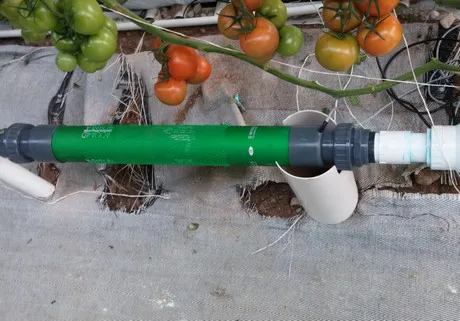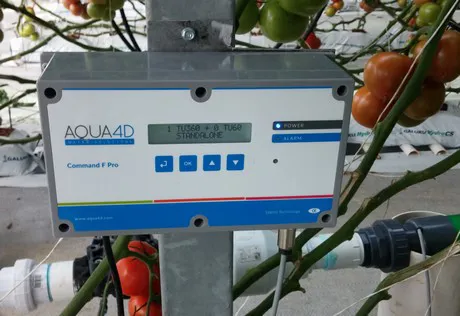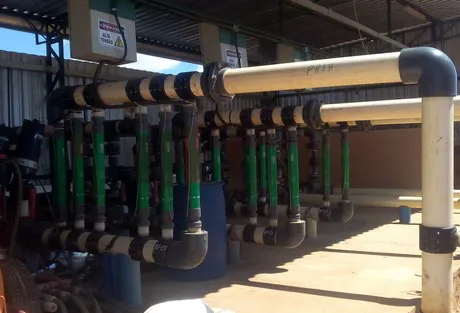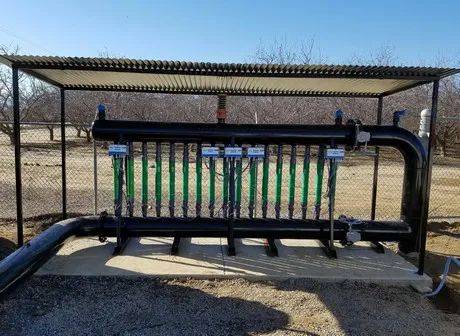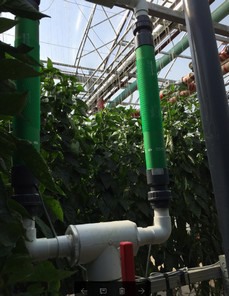Electromagnetic treatment of irrigation water is rapidly gaining ground in both greenhouse and open field production. After years of R&D and extensive trials in cooperation with commercial growers and research centers, Swiss company Aqua4D is installing its system in a growing number of countries.
Better quality irrigation water, solutions for salt saturated soils, efficient use of nutrients and fertilizers, stronger vigorous crops, a decrease of algae and biofilm in irrigation systems and more resistance to diseases such as nematodes. These are the claims that Aqua4D puts on the table. Their secret: a mysterious tube through which the irrigation water flows, just before it is sent towards the field.
According to Aqua4D, the magic happens inside their treatment unit in which electromagnetic signals modify the physical aspects of the water. “To make a long story short; the electromagnification changes the properties of the water, leading to a finer and more homogeneous state of the water and the salts and nutrients in it. Nutrients are dissolved and distributed much better and more easily absorbed by the plants., while excess water is trickled down well under the rhizosphere. There is no more crystallization of salts in the soil pores damaging the plant and the improved water retention allows for more water savings.”
Installation at a Mexican tomato grower.
While this still all sounds Greek to me and you cannot see what is happening inside the treatment unit, a lot of growers have been convinced by the technology due to the outstanding results it brought them after trials and commercial installations in their fields. The system has been installed in more than 32 countries, from a dozen of tubes at small commercial greenhouse operations in Canada, to installation on a 7,000 hectare drip-irrigated melon field in Brazil.
Control box in the greenhouse of a Mexican tomato grower.
Patrick Rosat, Sales Director at Aqua4D explained that the technology is proven and the story of their system spreads like wildfire. Especially in Latin America. "We have a dominant presence in markets where growers are challenged by a lack of good quality irrigation water. Water with high salinity levels, but also high salinity levels in the soil are a big problem here. Luckily, the farmers in these areas are eager to experiment with new, innovative, eco-friendly technologies, which is why we grew very fast in this market."
Other noteworthy markets named by Rosat are located in Central America. Mexico and Ecuador are big markets for greenhouse horticulture, but many growers are challenged by the salinity levels in their irrigation water. But also problems with nematodes or clogged irrigation pipes as a result of algae, biofilm and other materials can be reduced with the Aqua4D system.
"Our solution can be easily implemented in any kind of field or crop that makes use of some form of micro irrigation, whether it is via drip irrigation or via micro sprinklers. It comes in two sizes, a standard 2 inch version with a capacity to treat up to 22 m3 per hour and a smaller 1 inch version that can treat up to 3.6 m3 per hour", Rosat said when asked about the the technical aspects of the installation. He explained that the system is modular and works well with any kind of irrigation unit. "We have systems installed at growers that use Priva, Hoogendoorn and HortiMaX units, basically it does not matter what kind of unit is used, as the tubes are installed after the units. It is the last treatment the water receives before it's directed towards the crops."
Aqua4D installation at a California almond grower.
Rosat affirmed that the installation is designed in such a way that the treatment is powerful enough to last for more than 4 km in the irrigation system. "This is because the system changes the memory of the water, this prevents it from going back to its original state."
Aqua4D tubes in a Canadian greenhouse operation.
Aqua4D claims a reduce in fertilizer use of 30% and reports water savings up to 25%, against a very low power consumption. More information on the system can be obtained at their website
www.aqua4d-irrigation.com or by sending an email to
[email protected]
